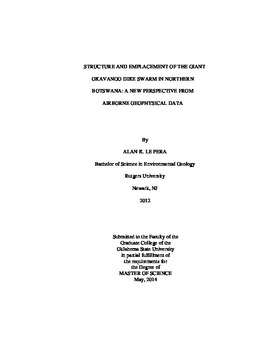| dc.contributor.advisor | Atekwana, Estella Akweseh | |
| dc.contributor.author | Le Pera, Alan Keith | |
| dc.date.accessioned | 2015-06-17T20:06:43Z | |
| dc.date.available | 2015-06-17T20:06:43Z | |
| dc.date.issued | 2014-05-01 | |
| dc.identifier.uri | https://hdl.handle.net/11244/14961 | |
| dc.description.abstract | The mode of emplacement of continental dike swarms extending across large distances remains enigmatic and the subject of debate. Here we examine the 1500 km long WNW-trending Okavango Dike Swarm (ODS) in Botswana, Africa suggested as representing a ~180Ma magmatic-tectonic event associated with the initial thermal weakening phase of Gondwana breakup. Historically, the ODS has been interpreted as a failed rift segment of a triple junction based on its geometric relationship with two other prominent dike swarms. Recent studies suggest instead that the ODS was emplaced along a preexisting Precambrian basement lineament. This work examines the lithospheric structural controls on the emplacement of the ODS using gravity and magnetic data. For this we have established the relationship between crustal heterogeneities and the swarm, identified variations in crustal thickness below the ODS, and determined along-strike variations in Curie point depth. Our results show: (1) no apparent basement structures with the same 110� orientation as the ODS, (2) crustal thickness below the swarm ranges from 39-45 km with an average of 42�3 km, indicating the lack of crustal thinning typically associated with rifting, (3) the magnetic basement beneath the swarm extends to a depth of about 24 km and is discontinuous along strike. These high susceptibility axial anomalies conceivably represent fossilized mid-crustal feeder chambers, similar to those found in continental spreading centers such as Afar and Iceland. The lack of significant thinning below the ODS and lack of parallelism with the Precambrian basement fabric suggest the ODS was not associated with a failed rift system and did not actively follow preexisting structures. The ODS is thus interpreted to have been emplaced within the upper crust through magma-enhanced fractures coupled with the presence of a ENE-WSW tensile stress orientation, induced by thermal insulation of the mantle below a stagnant supercontinent and uplift of the asthenosphere. | |
| dc.format | application/pdf | |
| dc.language | en_US | |
| dc.publisher | Oklahoma State University | |
| dc.rights | Copyright is held by the author who has granted the Oklahoma State University Library the non-exclusive right to share this material in its institutional repository. Contact Digital Library Services at lib-dls@okstate.edu or 405-744-9161 for the permission policy on the use, reproduction or distribution of this material. | |
| dc.title | Structure and Emplacement of the Giant Okavango Dike Swarm in Northern Botswana: a New Perspective from Airborne Geophysical Data | |
| dc.type | text | |
| dc.contributor.committeeMember | Abdel Salam, Mohamed | |
| dc.contributor.committeeMember | Pashin, Jack C. | |
| osu.filename | LePera_okstate_0664M_13245.pdf | |
| osu.accesstype | Open Access | |
| dc.description.department | Geology | |
| dc.type.genre | Thesis | |
| dc.subject.keywords | gondwana | |
| dc.subject.keywords | lithospheric structure | |
| dc.subject.keywords | okavango dike swarm | |
| dc.subject.keywords | palaeostress | |
| dc.subject.keywords | rifting | |
| dc.subject.keywords | triple junction | |
